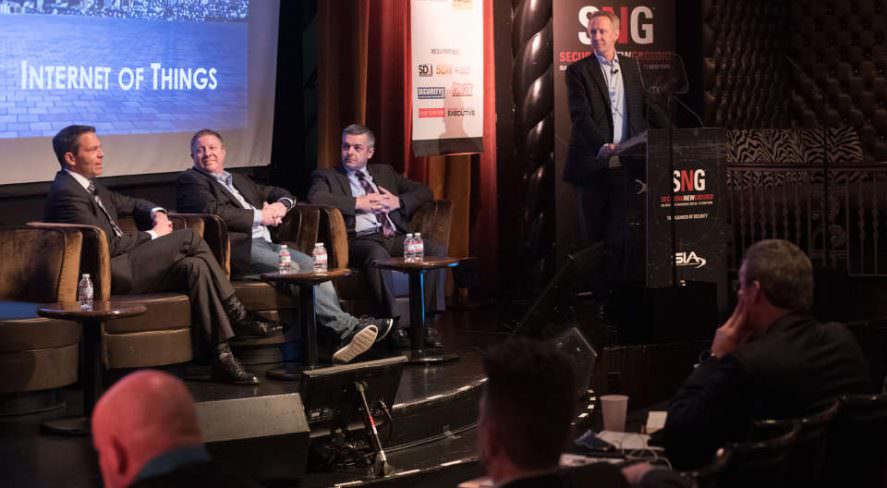Security Megatrends: The Forces Transforming Our Future

Security market leaders took to the stage at Securing New Ground (SNG) 2017 to discuss Security Megatrends™, overarching developments directing the progress of the security industry, in panel discussions on Thursday.
Some of the best minds in the industry convened for the first panel, Security Megatrends™: The Forces Transforming Our Future, assessing four market forces and how they are very intertwined. Moderator Steve Van Till, President and CEO, Brivo, and Chair, SIA Standards Committee, focused the discussion on the Internet of Things (IoT), mobile devices, smart data, and cybersecurity.
In a recent speech, the Chairman of Joint Chiefs of Staff addressed mission success with three questions, Van Till said. Do the troops have the right equipment? Do they have the right intelligence? And do they have the right training?
“We should ask ourselves the same questions,” Van Till said. “We tend to focus on the equipment part — after all. that’s what we as manufacturers do. We have a hammer for every nail.
“The Megatrends are talking about during this conference are really pushing the boundaries of that. we are able to address many more elements of mission success,” he added.
IoT must consist of equipment surely, but IoT devices become significant for their capabilities to collect data and feed intelligence. Mobile devices often represent the best way to distribute intelligence and training. Smart data points the most effective way to use Big Data through artificial intelligence. AI has a direct impact on intelligence and training, he said.
Meanwhile, cybersecurity is an inescapable element in every room today, Van Till said. Security companies require equipment as well as intelligence and training to combat cyberthreats.
Fredrik Nilsson, Vice President, Americas, AXIS Communications, cited a report that projected IoT would be a $11 trillion market by 2025. The growth of IoT has been obvious throughout the medical and engineering industries, but soon we will see everything connecting, he said.
IoT is everywhere, which is good… but also a challenge, Nilsson said. More connected devices result in a need for more vigilance to defend against cyberthreats.
For example, some observers may have dismissed hacking video cameras many years ago due to limited value in viewing their video footage. Security companies have seen in recent times, however, that hacking a camera can provide access to its connected networking, providing hackers with potential capabilities to take companies out of business very quickly, Nilsson said.
Rob Martens, Futurist and Vice President of Strategy and Partnerships, Allegion, observed that residential markets are leading technological innovation in the security industry today. In this way, residential markets are “crashing” into commercial markets.
Constant demand for less expensive and more available sensors have driven innovation while cheaper pipes for data and better tools to analyze it have expanded capabilities for the home.
Still, “our systems today are not ready to handle the volume of Big Data generated by IoT devices,” Martens said.
When Nest launched, it was not a very good thermostat according to independent analyses, he added. But it improved over time. Its software gave it the capacity to grow and improve.
In a similar manner, inexpensive sensors will gain more capability over time, Martens noted.
Considering mobile devices, oversaturation of applications will force mobile providers into more voice capabilities. Voice provides a more robust user interface, and mobile devices need not be limited by restrictions on how many apps they can hold. After voice, mobile devices will expand into AI.
“It’s all tied together,” Martens said. “Analytics and data and physical products are no longer separate. A live product is a digital product.”
He added, “If you have products in the field that don’t have over-the-air update capabilities, you should take the product out immediately.” It will be useless in the near future.
Martin Huddart, President of the Access and Egress Hardware Group, ASSA ABLOY, said a consumer has incredible power with a $500 solution that enables real-time access control. Deploying the same level of capability across a large enterprise in the commercial world requires a tremendous leap in scale.
Meanwhile, manufacturers face a challenge in that they must make technology easier to deploy, Huddart said. With the rapid pace of innovation today, a gap emerges between what’s possible and what’s doable. And so, manufacturers must think about deployment of solutions and how to make them easier to deploy for integrators.
Regarding mobile devices, large enterprises will be slow to adopt digital identities as their primary form of access control, for example.
Small businesses will find mobile identification appealing because they can reset access in real-time. Former employees are shut out instantly. No one should call a locksmith to reconfigure a door. Because digital identity can change in real time, it is very attractive for small businesses that can deploy and manage it easily. It will also become very popular at universities and colleges, where young early adopters will prefer mobile-first.
But in the Fortune 100 market, we will see a slower burn, Huddart said. Mobile identification will remain a secondary or backup credential for a while. Despite this, wise manufacturers are futureproofing, building mobile capabilities into their technologies even if not making use of them today.
These four market leaders have seen in their own experiences how Security Megatrends will work in tandem to pave the future landscape of the security marketplace. You can discover more in our future edition of Security Megatrends: The 2018 Vision for the Security Industry, slated for publication in November.
Save the date for SNG 2018, to be held on Oct. 25-26, 2018, at the Edison Ballroom in New York City. For more information, visit http://www.securingnewground.com.
